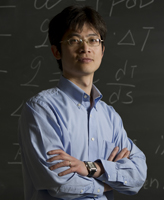Dr. Calvin Li Awarded NIH Funding to Develop New Prostate Cancer Treatment Approach
With two-year funding of more than $425,000 from the National Institutes of Health, Dr. Calvin Li, Assistant Professor of Mechanical Engineering, will explore the combined effect of thermotherapy and radiotherapy for late-stage prostate cancer. Together with his primary collaborator, Dr. Ishmael Parsai, Professor of Radiation Oncology at the University of Toledo and Director of its Medical Physics Division, Dr. Li will engage experts from the engineering, medical, and industrial sectors to advance this research.
“Adjuvant administration of radiation therapy with hyperthermia in cancer treatments has been studied extensively for about 30 years, but their simultaneous delivery through the same treatment source has not been documented,” says Dr. Li. “In this research, we hope to determine the feasibility of the development and implementation of a new thermo-brachytherapy seed that combines a sealed radioactive source with a ferromagnetic core, which will self-regulate heat output when implanted in tissue.”
The combination of a magnetic field and a self-regulating heat feature will preclude the need for invasive thermometry and ease heat delivery, especially to deep-seated tumors. The proposed seed is based on the conventional 125I seed commonly used for prostate implant, but the ferromagnetic core will replace the tungsten marker traditionally used as a heat source. “In addition to delivering both radiation and heat at the onset of cancer therapy, these seeds also could be used for thermal re-treatment of a tumor in the case of recurrence, possibly as a sensitizer to systemic therapies without another invasive procedure,” says Dr. Li.
Once the seed reaches its targeted treatment temperature range, heat production will decrease. This innovation reduces the need for hyperthermia treatments traditionally delivered by microwave and ultrasound applicators, which often result in limited penetration and require invasive thermometry.
In this investigation, researchers will conduct a complete dosimetric characterization and evaluation of the new dual-function seed using Monte Carlo simulation and finite element modeling; then the interdisciplinary research team will develop and manufacture a prototype to study its efficacy in the concurrent delivery of radiation and heat. The goal of this study is to develop a fully functional seed for clinical tests by commercializing the prototype.
According to the American Cancer Society, of the nearly 187,000 American men who will learn they have prostate cancer this year, one in six is at risk for a terminal prognosis. The technique proposed in this research has the potential to reduce this ratio and increase the probability of tumor control without a significant change in treatment regimens currently offered. This new seed could be integrated into the existing radiation delivery procedure or used for salvage therapy by re-heating the gland internally.

